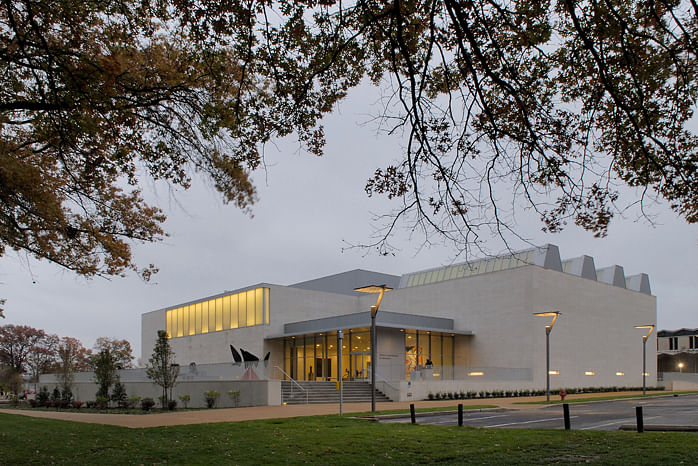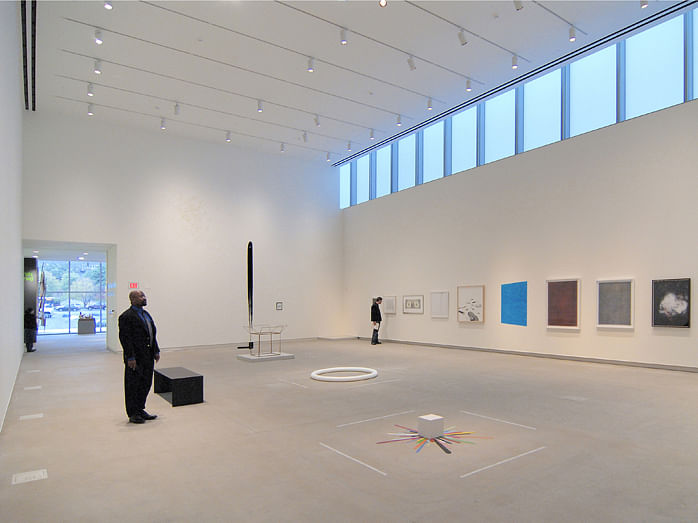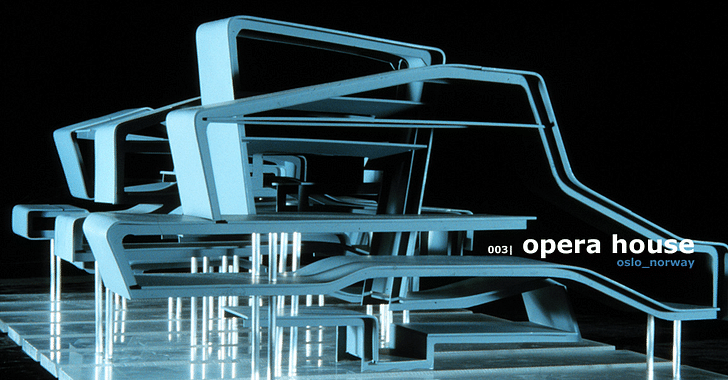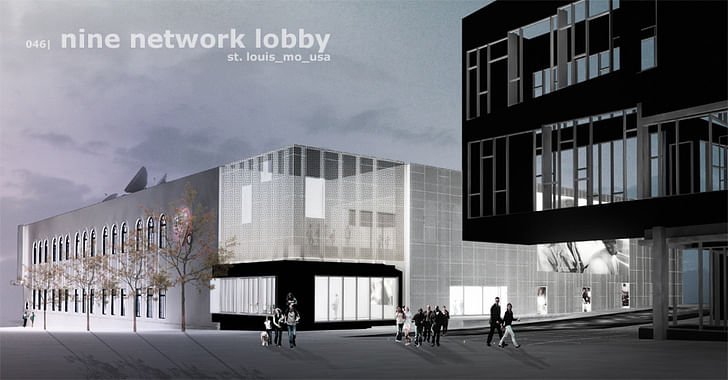

Heather Woofter is already a familiar face around the Sam Fox School of Design & Visual Arts at Washington University in St. Louis, where she's been teaching since 2005. She also practices what she teaches, having continued working with her design partner Sung Ho Kim at the firm Axi:Ome since she joined in 2003. Now that she's been appointed director of the respected design school's architecture programs, what are her pedagogical goals? She discusses her approach toward taking a school with one of the oldest established urban design programs in the country into the future in the interview below.
You joined Washington University in 2005 as an assistant professor, and became a full professor in 2015. What insights from that teaching experience do you hope to integrate or adopt as a director?
Education is one of the greatest gifts. We are given the time and space to consider different international perspectives, understand practice as a provocation to social, cultural, ecological and technical issues of our time, and engage with our city and community to propose alternative futures for critique and debate. Leading a school touches upon all of those relationships you experience as a teacher. It is a humbling exercise to help bring together talent and expertise to create a dynamic environment where scholarship and creativity flourish.
I joined Washington University in St. Louis prior to the reorganization of architecture, art, and museum, bringing us together under the umbrella of one school. The structural changes affected the pedagogy, structure, and direction of all programs. I believe there are valuable insights to be learned in the cooperation of allied disciplines. While research universities turn towards interdisciplinary agendas, design programs have specific challenges—to continue to value practice as a legitimate form of research, to solve problems at the magnitude of cities, environmental stability, and achieve a balance of cultural voices.

As a major research institution, the university’s capacity to bring design professionals, planners and research scholars to the urban community should result in a mutually beneficial strengthening of each. One cannot affect the city without understanding and implementing policy frameworks. Furthermore, unraveling the various narratives of a place reveals issues of social injustice and cultural forces that directly shape the world we attempt to make better. In this way, the city acts as a catalyst for research—in one instance, exemplifying the need for disciplines to come together to solve complex problems. Design thinking is a term being used across campuses; the schools of design are uniquely positioned to model collaborative work around real world problems.
Finally, I believe the immersion of teaching in one place for some time leads to a robust understanding of the school’s historical culture. Having received mentorship from previous design leaders and inspiring faculty, I’m motivated to honor their commitment. It is a great sense of responsibility to build on the work of others, and by example, imagine where the school may go in the future. Washington University in St. Louis has a long tradition of bringing together architects and urban designers practicing internationally, and the legacy of their contributions inspires us to be agile educators moving the school and design professions forward.
Briefly describe the school’s pedagogical stance on architecture education. How would you characterize the programming?
Our graduate architecture curriculum is designed around a model of practice and interdisciplinary education. We also have a strong culture of international programs, and share larger goals of the university to impact social and environmental challenges through multi-disciplinary initiatives. Our history theory strengths relate to the construct and critique of design practice, with faculty synergy in histories of urban design.
Our curriculum here embraces both the scientific and the design elements of the landscape
Washington University in St. Louis has one of the oldest established urban design programs, with a curriculum founded by Fumihiko Maki and Roger Montgomery in 1960. The UD program engages local, national, and global urbanization and includes a special focus on the creation of healthy and sustainable environments. Key to these efforts, our landscape architecture program was established shortly after the formation of the Sam Fox School, filling a crucial need to examine and reimagine ecological and landscape systems. We are located at the confluence of the Mississippi and Missouri Rivers, with 2/3 of the watershed of the country passing through—this puts us in a unique position to be at the center of climate change discussions and the formation of healthy ecological systems. Our curriculum here embraces both the scientific and the design elements of the landscape.
We have the structural flexibility to offer dual and joint degrees to our students in such a manner that two disciplines are experienced with immersion and moments of overlap to transfer ideas and encourage a holistic, multifaceted approach to design. Within our school we have dual degrees with architecture/urban design, architecture/landscape architecture, and urban design/landscape architecture. We have joint degrees with architecture/social work, architecture/construction management, architecture/business, and architecture/computer science.

We look to our curriculum to create synergies with design and research-oriented curricula. This effort acknowledges the need to advance our students’ intellectual curiosity, and provide scaffolding and opportunities for advanced study. Scholarly research creates new knowledge, provides a framework on which the school is founded, and directly impacts the work of designers by critically examining contemporary issues. We currently offer research specialization in the history and culture of architecture, and architectural pedagogy, with mentorship opportunities for those students interested in an academic career.
Scholarly research creates new knowledge, provides a framework on which the school is founded, and directly impacts the work of designers by critically examining contemporary issues.
We are also a school of designers. The undergraduate architecture students begin design studio in their first semester, with a rigorous combination of classes in the architecture program and undergraduate coursework with a broader population of university students, pairing continuous immersion in design culture with intellectual learning opportunities in arts and sciences. Many of our undergraduate students receive minors in studies outside the design discipline, as well as in landscape architecture and urban design. Their capstone project captures their unique educational path, with students designing an individualized research project in their final year.
With initiative support from the university, we started the Office of Socially Engaged Practice as a resource to build collaborative practices with our community. This is a unique program within our school—acting as a catalyst for research, teaching and practice. Projects here range from educational programming for St. Louis youth, to community initiatives, to collaborations with arts institutions around social issues. Led by an engineer with expertise in collaborative research and community-based design, the school has a unique structure to operate within—one that connects us to administrative and curricular resources across campus. Outside of this framework we also are expanding our research programs across graduate schools. Our current collaboration with the engineering school on the Solar Decathlon House is an example of the school’s commitment to sustainable practices in architecture, as well as a larger agenda to consider international dilemmas in housing.

What kind of student do you think would flourish at Washington University and why?
Students at Washington University in St. Louis don't necessarily fit one mold, and we purposely encourage diversity within our programs in order to better tackle design and scholarly challenges across a range of environments and cultures. As part of a tier-one research institution, students who are intellectually curious and research oriented thrive in our programs. We attract students interested in working in the city, with social-minded ambitions, as well as those artistically focused and with a passion for design and making. We are an international school; students participate in a global design discourse and our community is eager to collaborate and look for leadership opportunities in St. Louis and broader academic environments.
What are the biggest challenges, academically and professionally, facing your students?
The high cost of education impacts the professional path of our graduates, and affects the diversity of our student body. As the populations fluctuate based on world economies, it restricts our ability to establish balanced classes with representation of different regions of the world and socio-economic differences. At a time when divisions within society pose great threats to communities, it is all the more important to bring together a cohort of students with diversity patterns representing a general population.
We also believe housing and the creation of sustainable living environments is a fundamental and ongoing concern for architects in contemporary practice
We see divisions within the city of St. Louis, and the university is responding to those community challenges with increased planning and concern for the of values that represent good stewardship and collaboration with the city. In the architecture program, we received support through a Mellon Foundation initiative in architecture, urbanism, and the humanities for interdisciplinary teams examining cities, along with several other research institutions. Bruce Lindsey and Jean Allman lead the Divided City initiative addressing the question of segregation with teams of designers and humanities scholars.
We also believe housing and the creation of sustainable living environments is a fundamental and ongoing concern for architects in contemporary practice. For this reason, we explore the problem of housing on an international scale—with faculty and their housing projects located in cities around the world. We instituted studio rotations to promote collaboration among the faculty, increase dialogue between studios and educate students to the shaping of projects through cultural, climatic, and building dimensions. We broadened our school’s reach by recruiting practicing architects from various nationals to focus on their own culture and site within the context of a global dialogue.

What are the things that your school does to help their students find employment after graduation?
We have a dedicated career center for our undergraduate and graduate students in architecture, urban design, and landscape architecture, providing support and guidance in all stages of transition—including placement in practice, support to further pursue advance degrees, and broader connections to allied disciplines. The office builds career fairs, road shows visiting firms in select cities, skills workshops, career interest groups, and school-specific programming initiated by student request. We also benefit from larger initiatives on campus that include supported service opportunities with non-for-profit institutions, grant assistance to work for entrepreneurial start-ups, and connections to work with underserved communities.
Several of our students are part of larger university scholarship organizations including the Chancellor’s Fellowship and the Olin Fellowship—cohorts of students with programming opportunities and established networks of alum with diversity, community, and service orientation as well as opportunities to promote leadership advancement of women in academia and practice.
With long established programs in architecture, the school’s alumni base is large, international, and generously supportive of young graduates through their connections and mentorship efforts.

Do you have a method or process for deciding how to integrate what you see in your practice into academia?
There are universal experiences in practice that can be brought into an academic environment including principals of communication and collaboration, working across disciplinary boundaries, design thinking and conceptualizing a project context, considering building technologies and environmentally sensitive solutions, and working on design competitions and scholarly research projects that project forward-thinking questions in architecture to speculate on directions in the field. In practice, there is also a continual refinement and pursuit of craft, striving to make spaces and structures that are beautiful to inhabit. No building stands alone—it must be part of a larger history, network, and contribute to greater ambitions.
Practice offers us the possibility to bridge these ambitions with the realities of economy and technology
Practice offers us the possibility to bridge these ambitions with the realities of economy and technology. There are different ways that we can bring these experiences into the academic environment. For example, the faculty and I worked to promote community relationships through design projects in the city by establishing partnerships with community groups, arts organizations and developers. In a sample year, the graduate architecture program partnered with St. Louis Lambert International Airport, the Contemporary Art Museum, and UrbArts to work on projects in the community. These projects were initiated through connections working as an architect in the city. My hope was to initiate and sponsor faculty projects that would promote socially engaged learning and also jumpstart academic practices such that our teaching pedagogies and design practice goals align.

Do you have a relationship with the advertising methods that your school uses, and if so, what is your approach to that?
While we use advertising methods in searches, in journals, and professional organizations, our school generally promotes efforts in communication strategies rather than advertising venues per se.
How important do you think it is for the leader of an architecture school to either already have been or still to be a practicing architect?
I think it is important that leadership have a connection to research and aspirations to advance the profession. Practicing in architecture is one form of design research with a direct connection to the future work of many of our graduates. However, I believe it is important not to be narrowly focused in limiting the definition of research for our students. More so than other disciplines in the university, designers are in a unique position to challenge fundamental forms of education in an effort to solve complex problems. We look to open boundaries between work typically reviewed as scholarly and practices that are categorized as professional in order to create bridges between different forms of academic scholarship without diminishing the core value and depth of each pursuit. One challenges the other.
How do you familiarize yourself with trends within the architectural profession and academia, and adapt these observations into programming and student policy?
There are many ways to stay interconnected to the profession and broader academic institutions. Our school supports each design studio by inviting guests to critique student projects and faculty pedagogy—including professors from other schools, design professionals in practice, and technical specialists at the cutting edge of their discipline. We come together around the projects of our students to celebrate their hard work and also discuss future directions in architecture. We view final reviews as an opportunity for overlap, discussion, and debate. The interactions here influence our curriculum and also provide an outside voice essential to the growth of students and faculty together. Likewise, we travel and visit peer schools—seeing the work of our colleagues inspires us to consider alternative approaches, focus on unique aspects of our program while engaging in a broader discourse.
Students at Washington University in St. Louis seek global exchanges and experiences.
Students at Washington University in St. Louis seek global exchanges and experiences. Social and environmental issues motivate many, and our students seek opportunities to have an impact in local communities as well as global forums, such as participation in recent and upcoming events, such as the Denver Solar Decathlon, the Seoul Biennale, the annual NOMAS competition, AIA regional competition, and the Urban SOS: Fair Share competition, to name a few. They engage in local educational missions such as the Alberti program and City Faces. With our Office of Socially Engaged Practice, students have opportunities to work in real world situations, partnering with the Nature Conservancy, the Gephardt Institute, and Design for America. We also recently launched the Center for Health Research & Design, partnering on projects with our medical school to challenge contemporary healthcare environments by bringing together designers and medical professionals in a top-tier research university. Our students travel around the world, participating in immersive semester-long studios to cities such as Johannesburg, Barcelona, Florence, Buenos Aires, and Mumbai. In this way, we continue the legacy of the school as an international one— actively working to stay connected to contemporary challenges that face future generations of designers.

On a personal level, each of our faculty pursue research to stay current and motivate students through the work we love doing. I share a practice, Axi:Ome, with my partner Sung Ho Kim. Our built work centers on a concentration of public projects in St. Louis. Projects are typically long-term commitments, partnering with public institutions that value our ability to conceptually shape a project with diverse constituent voices. Work with Nine Network (the National Public Television station) and the University of Missouri St. Louis (the National Public Radio station) focus on transparency of the institution and their connections in the city, empowering citizens to take a more active role in the shaping of news media in both educational and advocacy roles. We also worked on an urban connector project entitled Artwalk in Grand Center, focusing on the need for connectivity, employing media and the arts to further our understanding of relevant needs in the community, and acting as responsible stewards to articulate this vision with environmentally engaged proposals. Our current collaborative work is a performing arts center, a diverse pre-professional and early childhood education center. The addition attempts to reinforce the gesture of an historic Eric Mendelsohn synagogue building. Outside of practice, I recently worked on a collaborative research project supported through the Mellon Foundation, Divided City, an urban humanities initiative intended to bring together humanities scholars and designers to study issues in segregation. We studied the political narrative surrounding the National Geospatial Agency’s move just north of the historic Pruitt Igoe site in a class entitled Citizen Space.
The disciplines of architecture, urban design, and landscape architecture rely on principals of exchange—no building stands alone —it belongs to a bigger network. Ethics, the environment, social consciousness, utility, technology, culture, infrastructure, and beauty all belong in the domain of designers, and so in this way, students and faculty alike thrive on connections and conversations outside of their school. Student voice is strong—we see students influencing programming and policy through their leadership skills gained in these outreaching experiences.
How would you like the school to have changed in your tenure?
The school has a strong history of practice to build on, and more recently the promise of interdisciplinary education through the formation of the Sam Fox School structure. Our dual degree students are highly sought for their breadth and depth of knowledge, as well as their bridge to practice. I look forward to a growing cohort of students that redefine research and practice through their thesis work, as well as increased faculty collaborations that inspire different approaches to research and pedagogical positions. Students are flexible and savvy—they are seeking new connections recently made possible by university efforts to break down the historic barriers of interdisciplinary education.
Washington University in St. Louis is a leading research institution and our faculty is highly productive in the creation of knowledge and critical positions in architecture. I would like to see the school increase its research agenda, expanding impact in design practice, social engagement, health and design, building technologies, and collaborations with the humanities.
By allowing the students to mix, we hope to find different forms of engaging the digital tools, with students retrofitting their output to find expressive forms of communication
We are located in St. Louis, a city of social and environmental complexity, and a place with high levels of accessibility for art and design collaborations. I would like to see us expand our presence in the city, strengthening our architecture, urban design and landscape architecture programs through partnership projects in the communities of St. Louis. We are interconnected with prominent international locations, and therefore feel a great sense of responsibility to provide different models of healthy living environments. Our emphasis on the city in urban design, history, and sustainable urbanism ties all of our disciplinary programs together. With one of the oldest programs in urban design, we have a history of building integrative practices and educating architecture students to have a cultural sensibility.
I would like to work with others to fulfill the promise initiated by the Sam Fox School and increase technical literacy of making across the disciplines. With shared resources in architecture, art, and a recent partnership with the Cortex Tech Shop, we have incredible resources to engage in making of all kinds. As a person educated during the pivotal years of the digital revolution, I am both a believer in new technologies and appreciative of my pre-digital education. It allows a hybridity of engagement that is not simply about the tool itself. In a joint effort, I hope we will continue to restructure our resources, opening up connections across disciplines to access a rich variety of tools in different settings. By allowing the students to mix, we hope to find different forms of engaging the digital tools, with students retrofitting their output to find expressive forms of communication.
Julia Ingalls is primarily an essayist. Her work has appeared or is forthcoming in Slate, Salon, Dwell, Guernica, The LA Weekly, The Nervous Breakdown, Forth, Trop, and 89.9 KCRW. She's into it.
No Comments
Block this user
Are you sure you want to block this user and hide all related comments throughout the site?
Archinect
This is your first comment on Archinect. Your comment will be visible once approved.